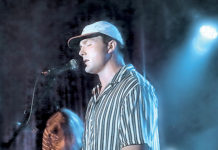Rated PG-13
By Joan Ellis
For all the right reasons, “The Theory of Everything” is an exhausting movie.
As we enter the life of Stephen Hawking (Eddie Redmayne), the 21-year- old Ph.D. candidate is racing happily around the Cambridge campus on a bicycle. Several scenes later a doctor tells the now symptomatic young man that he will be dead in two years of Motor Neuron Disease.
“Your thoughts won’t change, but no one will know what they are,” the good doctor says as he leaves Hawking sitting alone in the hospital hall.
This punch to the audience gut arrives just as we have begun to warm to the happy young fellow as he falls shyly in love with Jane (Felicity Jones). He tells her about his dream: to form a single, elegant equation that explains everything in the universe. And Jane, a degree candidate in language arts, responds with a mind that darts with wonder through a world of ideas.
As the story unfolds, the thought is inevitable: “That couldn’t happen in real life.” But it did happen in their real lives. Stephen Hawking is still alive in his 70s after a career spent forming his theory (see “A Brief History of Time”) and receiving honors all over the world. We see the enormity of what he accomplished with his intact brain and Jane’s care and understanding during his devastating disease.
If those are the bare bones of the actual Stephen Hawking story, it would be hard to exaggerate what Eddie Redmanyne and Felicity Jones have done in creating these characters on screen. Jones steers Jane through emotions that range from fierce protection of her husband to pride in his unaffected mind to eventual misery in the daily responsibilities of caring for him and their three children.
Redmayne takes Hawking from despair after the diagnosis through the next 50 years as a physicist of groundbreaking brilliance. Hawking’s movements, limited and often impossible, are familiar to the public, but Redmayne’s mastery of the condition at all stages of the disease and then in progression during the filming of the movie is extraordinary.
What sets Redmayne’s Hawking apart from most other courageous performances is the way he maintains his droll humor at the worst of times. His responses, often one-sentence shots coming through the computerized voice, come from Hawking’s still-brilliant mind.
Redmayne and Jones are given fine support by Harry Lloyd as Hawking’s college pal, Dennis Sciama as his professor and then by the two people they eventually love. Elaine Mason plays his nurse and Charlie Cox is choirmaster Jonathan Hellyer Jones who had been integral in the daily life of caretaking and raising the family before the years took their toll on the Hawkings’ marriage.
Eddie Redmayne’s ability to convey genius, humor and acceptance – even after Hawking couldn’t move his formerly expressive facial muscles – is overwhelming. His portrait of a brain undamaged in a body destroyed is a brilliant acting achievement.
Joan Ellis’ address on the Internet, which contains her review library, is JoanEllis.com.














